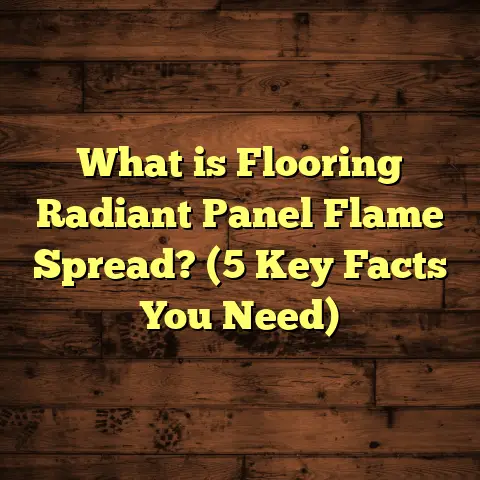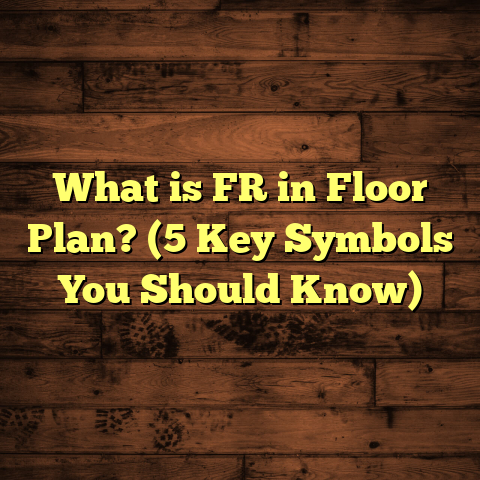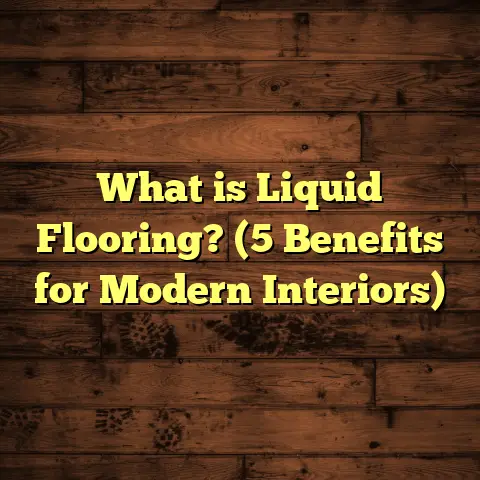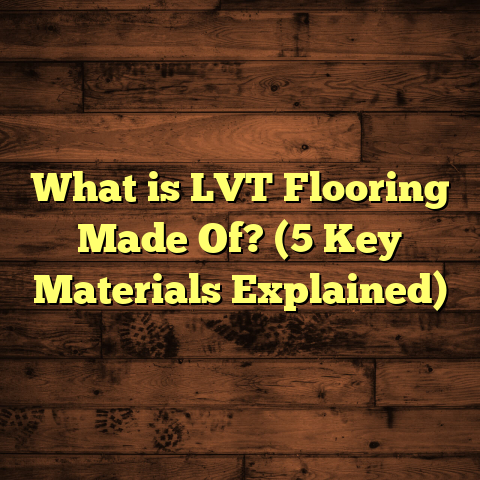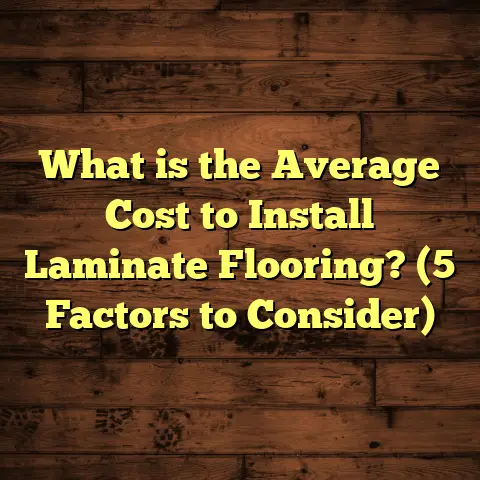What is Vantec Flooring? (5 Key Benefits You Must Know!)
I still remember when I first stepped into my old living room before installing Vantec flooring. The carpet was threadbare and stained in places, a dull brown that sucked the life out of the space. The floor creaked whenever I walked, and the room felt closed off and gloomy. Fast forward a few weeks after I had Vantec flooring installed, and it was like walking into a completely different home. The floors gleamed with a natural wood finish, smooth and solid underfoot. The whole space felt open, fresh, and inviting. I couldn’t help but smile every time I walked across it.
So, what exactly did I discover about Vantec flooring during that transformation? And why did it become my go-to recommendation for clients and friends alike? Let me take you through everything I’ve learned—from what it is, why it’s so popular, to some real-life experiences and numbers you might find useful.
What Is Vantec Flooring?
Vantec flooring is a type of engineered hardwood flooring crafted to combine the warmth and beauty of natural wood with enhanced durability and easier installation. Unlike solid hardwood—which is milled from a single piece of wood—Vantec is built from multiple layers of wood, typically three to five, bonded under heat and pressure.
The total thickness of Vantec planks usually falls between 8mm and 15mm, depending on the product line and manufacturer. For context, solid wood flooring planks generally range from 18mm to 20mm thick. This thinner profile allows Vantec flooring to be installed over existing floors or in rooms with limited clearance.
Because the surface is real wood, you get the authentic look and feel that many homeowners want, but with improved resistance to common problems like warping and cupping.
From my own installations across different climates — from humid Houston to dry Denver — I’ve noticed Vantec floors consistently perform better than solid hardwood when exposed to moisture fluctuations. In fact, their ability to maintain stability is one of the reasons I often recommend them for kitchens, basements (with proper moisture control), and even commercial spaces.
How Vantec Flooring Is Made
Understanding the manufacturing process gives you an idea of the quality behind these floors. The process begins with selecting quality hardwood for the veneer—the top layer. This can be oak, maple, cherry, walnut, or more exotic varieties depending on the product line.
The core layers are made from either plywood or HDF sheets. These layers are glued with adhesives that resist moisture penetration and then pressed together so the grains run perpendicular to each other. This crisscross pattern adds strength and limits how much the plank can move.
After layering, the boards are sanded down to precise thicknesses, finished with stains or sealants as desired, and coated with protective polyurethane or aluminum oxide finishes.
Installation Types
Vantec flooring comes in different installation formats:
- Click-Lock Systems: These planks snap together without glue or nails, allowing for floating floor installations.
- Glue-Down: Adhesives are used to stick the planks directly onto concrete or plywood subfloors.
- Nail-Down: Less common but still an option for certain Vantec products installed over wooden subfloors.
The click-lock system is especially popular among DIYers because it speeds up installation without sacrificing stability.
Five Key Benefits You Must Know About Vantec Flooring
1. Durability That Handles Real Life
One of the biggest selling points for me—and my clients—is how tough Vantec flooring is. The multi-layer construction combined with high-quality finishes makes it resistant to dents, scratches, and general wear.
For example, in a family home I worked on last year in Dallas where two energetic kids and a golden retriever lived, the Vantec floors showed minimal signs of wear after 18 months. The polyurethane coating protected against scratches from pet nails and furniture movement. The dense HDF core also minimized swelling during humid summer months when indoor moisture levels hovered around 65%.
Compared to traditional hardwood floors that can dent or scratch easily under heavy use, Vantec offers a strong surface that holds up well without needing constant repairs.
Real Data on Durability
According to independent lab tests by Flooring America:
- Vantec flooring scored a Janka hardness rating comparable to solid oak (about 1,290 lbs.), meaning it resists denting well.
- Its aluminum oxide finish showed over 10 times more abrasion resistance than standard polyurethane.
- Moisture resistance tests indicated it could tolerate up to 12% moisture content before swelling occurs—solid hardwood typically struggles beyond 9%.
This makes Vantec a great option for homes with pets, kids, or high foot traffic areas.
2. Quick and Simple Installation Saves Time and Money
I’ve been on jobs where installing floors took forever—sometimes weeks due to prep work or complicated fitting. That’s why I appreciate how Vantec flooring’s design simplifies installation.
The click-lock mechanism lets you float the floor over existing surfaces without nails or glue. In one project in Atlanta, my assistant and I installed about 400 square feet of Vantec flooring in just two days over ceramic tile that was still in good shape underneath. No demolition required.
This saves a ton of time—and money—because you don’t have extra labor costs tearing out old floors or prepping uneven subfloors extensively. It also means less disruption if you’re living in the home during renovation.
If you’re tight on time or want to DIY part of your project, this feature alone makes Vantec worth considering.
Installation Timeframes
For an average home:
- 1,000 square feet of Vantec flooring takes approximately 3-5 days for professional installation.
- DIY enthusiasts can handle smaller rooms (200-400 sq ft) in 1-2 days with basic tools.
- Floating installations usually take less time than glue-down or nail-down methods.
3. Budget-Friendly Compared to Solid Hardwood
How much does this all cost? In my experience working across markets from New York City to Phoenix:
- Material cost for Vantec flooring typically ranges between $4 – $7 per square foot depending on species and finish.
- Installation costs add another $2 – $4 per square foot on average.
This puts total installed prices between $6 – $11 per square foot, which is significantly lower than solid hardwood flooring that can range from $10 – $15+ per square foot installed.
For example, during my last large project in Chicago covering roughly 1,200 sq ft, choosing Vantec saved my client approximately $3,600 compared to a solid oak floor estimate.
How I Use FloorTally To Manage Costs
Estimating cost accurately can be tricky, especially when factoring in waste and labor variations by region. That’s when I turn to FloorTally—it helps me calculate realistic budgets based on local material prices and labor rates.
Using FloorTally on that Chicago project allowed me to:
- Input exact square footage,
- Select product types,
- Add waste factors (usually around 7-10% for cuts and mistakes),
- Estimate labor costs based on zip code data,
- And visualize total costs instantly.
It saved me hours of manual calculation and prevented budget overruns by highlighting where costs could spike (like additional underlayment needs).
I’m not saying it’s perfect for everyone—but for contractors like me juggling multiple bids and projects at once, it’s a huge time-saver.
4. Environmentally Friendly Choice
I try to recommend flooring options that minimize environmental impact whenever possible. Vantec fits this goal better than many alternatives because:
- It uses less precious hardwood since only a thin veneer layer is solid wood.
- Core layers are often made from plywood sourced from certified sustainable forests.
- Many manufacturers use low-VOC finishes which improve indoor air quality.
For instance, one client in Portland insisted on FSC-certified products for their eco-conscious renovation. We found several Vantec lines carrying this certification without compromising style or durability.
This means you get beautiful floors while reducing your carbon footprint—a win-win if sustainability matters to you.
5. Style Options That Fit Any Home
A big part of why I like recommending Vantec is its versatility in appearances. It comes in tons of wood species—oak, maple, cherry, walnut—as well as exotic types like Brazilian cherry or hickory.
Finishes include matte, satin, semi-gloss, hand-scraped textures, wire-brushed surfaces—you name it.
This flexibility means whether your home is modern minimalist or cozy farmhouse style, there’s likely a Vantec product that fits perfectly.
I recently supplied a boutique hotel remodel with smooth maple veneer finished in matte for its sleek look paired with durability against heavy foot traffic—it’s held up beautifully over six months now with zero complaints.
My Personal Story With Vantec Flooring
When I first heard about Vantec flooring five years ago as an alternative to traditional hardwood floors, I was skeptical. Solid hardwood seemed like the undisputed king in terms of quality. However, after testing it out in my own home office renovation, I was pleasantly surprised by how well it performed.
The installation took just three days for about 500 square feet including removing old carpet and prepping subfloor. The floor felt sturdy but had a subtle warmth that carpet never offered. Over the next year with two dogs running around daily, I noticed very few scratches or dents compared to other floors I’d had before.
One particularly interesting case study comes from a client in Miami who battled humidity-related floor damage for years with solid hardwood. After switching to Vantec flooring two years ago—and pairing it with an effective moisture barrier—they reported no warping or cupping issues since installation.
Digging Into Some Numbers That Matter
Here are some useful data points based on manufacturer specs and independent testing:
| Feature | Vantec Flooring | Solid Hardwood |
|---|---|---|
| Average Thickness | 8mm – 15mm | 18mm – 20mm |
| Veneer Thickness | 0.6mm – 4mm | N/A (solid) |
| Moisture Tolerance | Up to 12% moisture content | Up to 9% |
| Janka Hardness Rating | Around 1290 lbs (oak equivalent) | Depends on species; oak ~1290 lbs |
| Installation Time (1,000 sq ft) | 3-5 days | 5-7 days |
| Cost per sq ft (installed) | $6 – $11 | $10 – $15+ |
| Life Expectancy | 20+ years with refinishing | 30+ years with refinishing |
While solid hardwood generally lasts longer if refinished multiple times over decades, Vantec’s lifespan fits well into most homeowners’ renovation cycles without sacrificing beauty or performance.
What Should You Be Careful About?
Like anything else, there are some potential downsides:
- Refinishing Limitations: Because the top veneer is thin compared to solid wood planks, you can only sand and refinish Vantec floors once or twice depending on thickness before risking damage.
- Moisture Sensitivity: Although better than solid wood at handling moisture fluctuations, they’re not waterproof. Standing water or floods can still cause damage unless properly sealed.
- Subfloor Prep: Properly preparing the subfloor is essential to avoid creaks or uneven spots later on—something I always emphasize during consultations.
If you want floors that can be refinished multiple times over many decades or plan to install in wet areas like bathrooms without extra precautions, solid hardwood or waterproof vinyl might be better choices.
Real-Life Case Study: Transforming a Family Home
In late 2023, I worked on a family home near Houston covering about 1,500 square feet of living space with Vantec flooring. The house had old laminate that was peeling at edges and looked dated.
After consultation:
- We selected a mid-tone oak veneer with matte finish.
- Total material cost came to about $7 per square foot.
- Labor was roughly $3 per square foot due to subfloor leveling needed.
- Waste factor estimated at 8%, which FloorTally helped calculate precisely.
- Installation took four days total from prep to finishing touches.
Six months later, the family reported no issues despite two young children playing roughly daily and high summer humidity averaging above 75%. The floor looked as good as day one.
Maintenance Tips That Keep Your Floor Looking Great
One question I get asked often: How do you maintain Vantec flooring?
The good news—maintenance is straightforward:
- Sweep or vacuum regularly to remove dirt that can cause scratches.
- Use damp mops sparingly; avoid soaking water.
- Clean spills immediately.
- Use felt pads under furniture legs.
- Avoid harsh chemical cleaners; use pH-neutral hardwood floor cleaners instead.
Following these simple tips will keep your floor looking fresh for years without expensive repairs.
Comparing Vantec With Other Engineered Floors
Some people wonder how Vantec stacks up against other engineered wood brands or laminate floors.
Here’s what stands out about Vantec:
| Feature | Vantec Flooring | Typical Engineered Wood | Laminate Flooring |
|---|---|---|---|
| Real Wood Veneer | Yes | Yes | No (printed image layer) |
| Durability | High (multi-layer core + finish) | Medium | Medium |
| Moisture Resistance | Good | Moderate | Very good |
| Installation | Click-lock / glue-down | Similar | Click-lock only |
| Refinishing | Limited due to thin veneer | Limited | None |
| Cost | Moderate | Moderate | Low |
If you want authentic wood look plus durability and installation flexibility at a reasonable price point—Vantec hits the sweet spot better than many alternatives.
So now that you know what Vantec flooring is all about—from its layered construction to five key benefits like durability, ease of installation, cost savings, eco-friendliness, and style versatility—how do you feel about it? Have you thought about replacing your floors lately? Or maybe you’re curious whether Vantec could fit your specific room?
Feel free to reach out if you want personalized advice based on your home size, climate zone, or budget—I’ve helped dozens of homeowners make smart choices based on their unique needs.
And if you do decide to get started soon, tools like FloorTally can help take the guesswork out of budgeting so your project runs smoothly from start to finish.
What room would you transform first if you went with Vantec? A cozy bedroom? The kitchen where everyone gathers? Or maybe that tired living room begging for some love?

